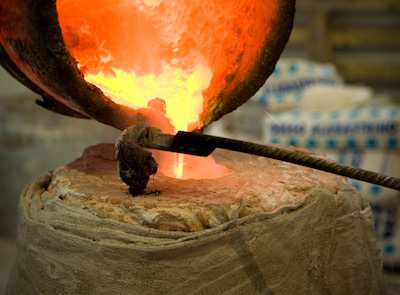
There are plenty of casting services available in today’s market. Two of the more basic and popular are die casting and sand casting. Below we dive into what each type of casting involves, as well as the benefits and costs of each. This will be helpful to determine which type of casting best suits your next project.
What is Die Casting?
The die casting process consists of red hot liquid metal forced into a die under extreme pressure. In this scenario, the “die” is simply the steel mold which is created to shape the actual product that is being manufactured. Once the liquid metal is poured and injected into the mold, it solidifies, and then is removed from the mold. As soon as the liquid metal cools down, the gating material which is used as a protection source for the liquid metal, is removed and the product is finished. The steel mold is then closed and is immediately ready for your next casting project. This entire cycle is lightning fast, and lasts anywhere between thirty seconds and one minute.
What is Sand Casting?
 The sand casting process consists of molten metal poured typically from a ladle into a sand mold. Unlike with die casting, no high pressure is necessary for this process. The sand mold is created when a matchplate, or a pattern made out of wood or plastic, is placed into an enclosure. Sand is then distributed around the matchplate and inside the enclosure. Once the sand is packed in, the matchplate is then removed and the cavity is inserted with molten metal. The metal then solidifies, the mold is opened and the sand is dusted off the hot casing, and the casting is complete. Unlike die casting, the mold needs around five minutes of down and prep time, before it can be reused again.
The sand casting process consists of molten metal poured typically from a ladle into a sand mold. Unlike with die casting, no high pressure is necessary for this process. The sand mold is created when a matchplate, or a pattern made out of wood or plastic, is placed into an enclosure. Sand is then distributed around the matchplate and inside the enclosure. Once the sand is packed in, the matchplate is then removed and the cavity is inserted with molten metal. The metal then solidifies, the mold is opened and the sand is dusted off the hot casing, and the casting is complete. Unlike die casting, the mold needs around five minutes of down and prep time, before it can be reused again.
Die Casting vs Sand Casting
The biggest and most obvious difference between the die and sand casting process is the materials used to form the molds. As we reviewed above, die casting uses a metal mold, while sand casting uses a mold made out of sand. Below we point out the benefits of each process, as well as which applications each are used for.
Die Casting Advantages
- High speed production
- Aids in simplified assembly
Sand Casting Advantages
- Low tooling cost
- More flexibility with size, shapes and weights
- Alloy friendly – can be used with almost any type
Both forms of casting are widely used across multiple industries today. Each type helps accomplish a final production goal. A job that requires precision and complex shapes, like medical device manufacturing, would be best suited for die casting. Any high volume job would fall under the die casting category, based on the quick turnaround time this process offers. For a job that requires a strict budget that will be producing larger pieces and parts, such as a furniture maker, sand casting would be ideal.
Wondering which type of casting might be best for your application? Contact us at Patriot Foundry today!














